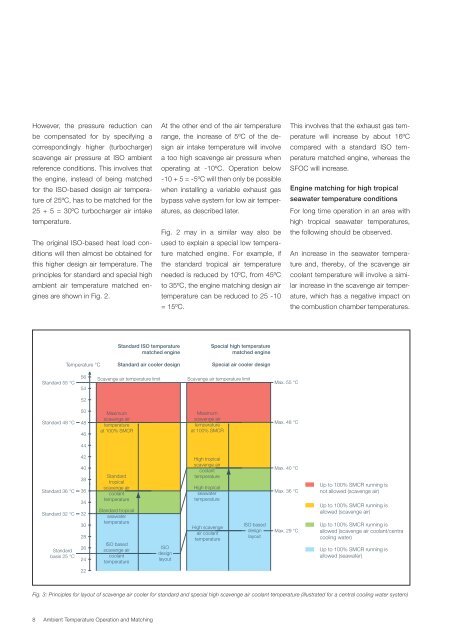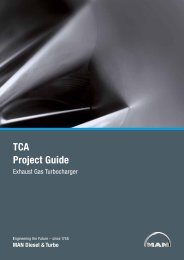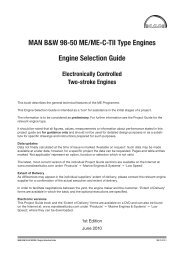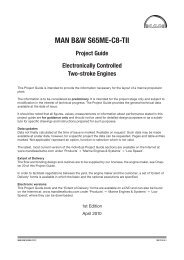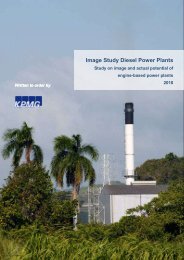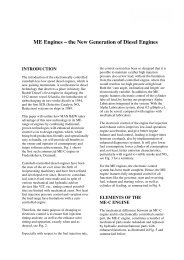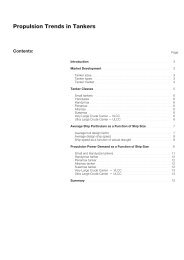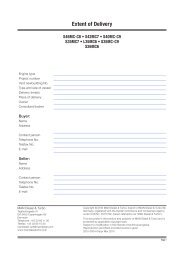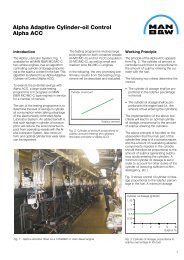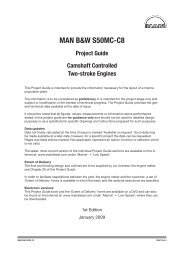Ambient Temperature Operation and Matching - MAN Diesel & Turbo
Ambient Temperature Operation and Matching - MAN Diesel & Turbo
Ambient Temperature Operation and Matching - MAN Diesel & Turbo
Create successful ePaper yourself
Turn your PDF publications into a flip-book with our unique Google optimized e-Paper software.
However, the pressure reduction can<br />
be compensated for by specifying a<br />
correspondingly higher (turbocharger)<br />
scavenge air pressure at ISO ambient<br />
reference conditions. This involves that<br />
the engine, instead of being matched<br />
for the ISO-based design air temperature<br />
of 25ºC, has to be matched for the<br />
25 + 5 = 30ºC turbocharger air intake<br />
temperature.<br />
The original ISO-based heat load conditions<br />
will then almost be obtained for<br />
this higher design air temperature. The<br />
principles for st<strong>and</strong>ard <strong>and</strong> special high<br />
ambient air temperature matched engines<br />
are shown in Fig. 2.<br />
St<strong>and</strong>ard 55 °C<br />
St<strong>and</strong>ard 48 °C<br />
St<strong>and</strong>ard 36 °C<br />
St<strong>and</strong>ard 32 °C<br />
St<strong>and</strong>ard<br />
basis 25 °C<br />
<strong>Temperature</strong> °C<br />
56<br />
54<br />
52<br />
50<br />
48<br />
46<br />
44<br />
42<br />
40<br />
38<br />
36<br />
34<br />
32<br />
30<br />
28<br />
26<br />
24<br />
22<br />
Maximum<br />
scavenge air<br />
temperature<br />
at 100% SMCR<br />
St<strong>and</strong>ard<br />
tropical<br />
scavenge air<br />
coolant<br />
temperature<br />
St<strong>and</strong>ard tropical<br />
seawater<br />
temperature<br />
ISO based<br />
scavenge air<br />
coolant<br />
temperature<br />
St<strong>and</strong>ard ISO temperature<br />
matched engine<br />
St<strong>and</strong>ard air cooler design<br />
8 <strong>Ambient</strong> <strong>Temperature</strong> <strong>Operation</strong> <strong>and</strong> <strong>Matching</strong><br />
At the other end of the air temperature<br />
range, the increase of 5ºC of the design<br />
air intake temperature will involve<br />
a too high scavenge air pressure when<br />
operating at -10ºC. <strong>Operation</strong> below<br />
-10 + 5 = -5ºC will then only be possible<br />
when installing a variable exhaust gas<br />
bypass valve system for low air temperatures,<br />
as described later.<br />
Fig. 2 may in a similar way also be<br />
used to explain a special low temperature<br />
matched engine. For example, if<br />
the st<strong>and</strong>ard tropical air temperature<br />
needed is reduced by 10ºC, from 45ºC<br />
to 35ºC, the engine matching design air<br />
temperature can be reduced to 25 -10<br />
= 15ºC.<br />
ISO<br />
design<br />
layout<br />
Maximum<br />
scavenge air<br />
temperature<br />
at 100% SMCR<br />
High tropical<br />
scavenge air<br />
coolant<br />
temperature<br />
High tropical<br />
seawater<br />
temperature<br />
High scavenge<br />
air coolant<br />
temperature<br />
Special high temperature<br />
matched engine<br />
Special air cooler design<br />
Scavenge air temperature limit Scavenge air temperature limit<br />
ISO based<br />
design<br />
layout<br />
Max. 55 °C<br />
Max. 48 °C<br />
Max. 40 °C<br />
Max. 36 °C<br />
Max. 29 °C<br />
This involves that the exhaust gas temperature<br />
will increase by about 16ºC<br />
compared with a st<strong>and</strong>ard ISO temperature<br />
matched engine, whereas the<br />
SFOC will increase.<br />
Engine matching for high tropical<br />
seawater temperature conditions<br />
For long time operation in an area with<br />
high tropical seawater temperatures,<br />
the following should be observed.<br />
An increase in the seawater temperature<br />
<strong>and</strong>, thereby, of the scavenge air<br />
coolant temperature will involve a similar<br />
increase in the scavenge air temperature,<br />
which has a negative impact on<br />
the combustion chamber temperatures.<br />
Up to 100% SMCR running is<br />
not allowed (scavenge air)<br />
Up to 100% SMCR running is<br />
allowed (scavenge air)<br />
Up to 100% SMCR running is<br />
allowed (scavenge air coolant/central<br />
cooling water)<br />
Up to 100% SMCR running is<br />
allowed (seawater)<br />
Fig. 3: Principles for layout of scavenge air cooler for st<strong>and</strong>ard <strong>and</strong> special high scavenge air coolant temperature (illustrated for a central cooling water system)


